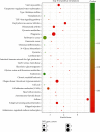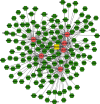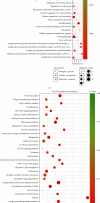Bioinformatics Analysis of ceRNA Network Related to Polycystic Ovarian Syndrome
- PMID: 34211581
- PMCID: PMC8208863
- DOI: 10.1155/2021/9988347
Bioinformatics Analysis of ceRNA Network Related to Polycystic Ovarian Syndrome
Abstract
Introduction: Polycystic ovary syndrome (PCOS) is caused by the hormonal environment in utero, abnormal metabolism, and genetics, and it is common in women of childbearing age. A large number of studies have reported that lncRNA is important to the biological process of cancer and can be used as a potential prognostic biomarker. Thus, we studied lncRNAs' roles in PCOS in this article.
Methods: We obtained mRNAs', miRNAs', and lncRNAs' expression profiles in PCOS specimens and normal specimens from the National Biotechnology Information Gene Expression Comprehensive Center database. The EdgeR software package is used to distinguish the differentially expressed lncRNAs, miRNAs, and mRNAs. Functional enrichment analysis was carried out by the clusterProfiler R Package, and the lncRNA-miRNA-mRNA interaction ceRNA network was built in Cytoscape plug-in BiNGO and Database for Annotation, Visualization, and Integration Discovery (DAVID), respectively.
Results: We distinguished differentially expressed RNAs, including 1087 lncRNAs, 14 miRNAs, and 566 mRNAs in PCOS. Among them, 410 lncRNAs, 11 miRNAs, and 185 mRNAs were contained in the ceRNA regulatory network. The outcomes from Gene Ontology (GO) analysis showed that the differentially expressed mRNAs (DEMs) were mainly enriched in response to the maternal process involved in female pregnancy, morphogenesis of embryonic epithelium, and the intracellular steroid hormone receptor signaling pathway. The Kyoto Encyclopedia of Genes and Genomes (KEGG) pathway analysis data showed that DEMs were primarily enriched in pathways related to the TGF-β signaling pathway, Type I diabetes mellitus, and glycolysis/gluconeogenesis. In addition, we chose NONHSAT123397, ENST00000564619, and NONHSAT077997 as key lncRNAs due to their high bearing on PCOS.
Conclusion: ceRNA networks play an important role in PCOS. The research indicated that specific lncRNAs were related to PCOS development. NONHSAT123397, ENST00000564619, and NONHSAT077997 could be regarded as potential diagnostic mechanisms and biomarkers for PCOS. This discovery might provide more effective and more novel insights into the mechanisms of PCOS worthy of further exploration.
Copyright © 2021 Yuanqi Li and Yong Tan.
Conflict of interest statement
The authors declare that they have no conflicts of interest.
Figures













Similar articles
-
Exosomal lncRNA and mRNA profiles in polycystic ovary syndrome: bioinformatic analysis reveals disease-related networks.Reprod Biomed Online. 2022 May;44(5):777-790. doi: 10.1016/j.rbmo.2022.01.007. Epub 2022 Jan 31. Reprod Biomed Online. 2022. PMID: 35337736
-
Identification of Crucial lncRNAs, miRNAs, mRNAs, and Potential Therapeutic Compounds for Polycystic Ovary Syndrome by Bioinformatics Analysis.Biomed Res Int. 2020 Nov 6;2020:1817094. doi: 10.1155/2020/1817094. eCollection 2020. Biomed Res Int. 2020. PMID: 33224973 Free PMC article.
-
Construction of a competing endogenous RNA network to identify drug targets against polycystic ovary syndrome.Hum Reprod. 2022 Nov 24;37(12):2856-2866. doi: 10.1093/humrep/deac218. Hum Reprod. 2022. PMID: 36223608
-
Identification of MFI2-AS1, a Novel Pivotal lncRNA for Prognosis of Stage III/IV Colorectal Cancer.Dig Dis Sci. 2020 Dec;65(12):3538-3550. doi: 10.1007/s10620-020-06064-1. Epub 2020 Jan 20. Dig Dis Sci. 2020. PMID: 31960204 Review.
-
Reconstruction and Analysis of the Differentially Expressed IncRNA-miRNA-mRNA Network Based on Competitive Endogenous RNA in Hepatocellular Carcinoma.Crit Rev Eukaryot Gene Expr. 2019;29(6):539-549. doi: 10.1615/CritRevEukaryotGeneExpr.2019028740. Crit Rev Eukaryot Gene Expr. 2019. PMID: 32422009 Review.
Cited by
-
Glycolytic Dysfunction in Granulosa Cells and Its Contribution to Metabolic Dysfunction in Polycystic Ovary Syndrome.Drug Des Devel Ther. 2025 Jun 18;19:5255-5270. doi: 10.2147/DDDT.S525651. eCollection 2025. Drug Des Devel Ther. 2025. PMID: 40546660 Free PMC article. Review.
-
Role of Bioinformatics Analysis in Early Differential Diagnosis of Ovarian Cancer.Contrast Media Mol Imaging. 2022 Sep 16;2022:6129817. doi: 10.1155/2022/6129817. eCollection 2022. Contrast Media Mol Imaging. 2022. Retraction in: Contrast Media Mol Imaging. 2023 Jul 19;2023:9865348. doi: 10.1155/2023/9865348. PMID: 36185577 Free PMC article. Retracted.
-
Image Analysis of TVCDS in Infertile Patients with Polycystic Ovary Syndrome.Contrast Media Mol Imaging. 2022 Jun 17;2022:1234983. doi: 10.1155/2022/1234983. eCollection 2022. Contrast Media Mol Imaging. 2022. Retraction in: Contrast Media Mol Imaging. 2023 Jul 12;2023:9843291. doi: 10.1155/2023/9843291. PMID: 35821885 Free PMC article. Retracted.
References
MeSH terms
Substances
LinkOut - more resources
Full Text Sources
Medical

